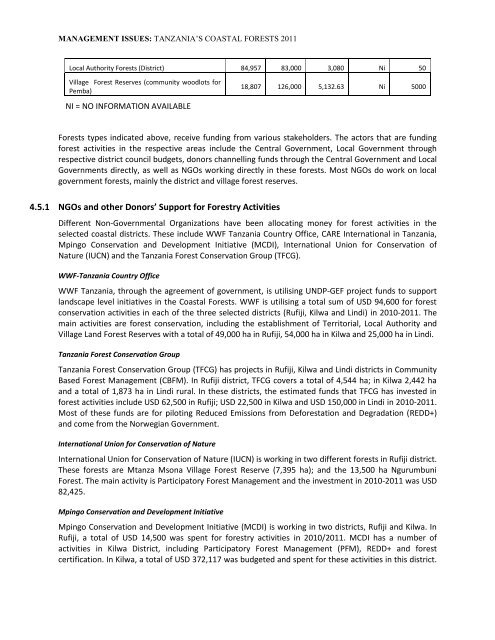Neil D. Burgess, Paul Harrison, Peter Sumbi, James Laizer, Adam ...
Neil D. Burgess, Paul Harrison, Peter Sumbi, James Laizer, Adam ...
Neil D. Burgess, Paul Harrison, Peter Sumbi, James Laizer, Adam ...
You also want an ePaper? Increase the reach of your titles
YUMPU automatically turns print PDFs into web optimized ePapers that Google loves.
MANAGEMENT ISSUES: TANZANIA’S COASTAL FORESTS 2011<br />
Local Authority Forests (District) 84,957 83,000 3,080 Ni 50<br />
Village Forest Reserves (community woodlots for<br />
Pemba)<br />
NI = NO INFORMATION AVAILABLE<br />
18,807 126,000 5,132.63 Ni 5000<br />
Forests types indicated above, receive funding from various stakeholders. The actors that are funding<br />
forest activities in the respective areas include the Central Government, Local Government through<br />
respective district council budgets, donors channelling funds through the Central Government and Local<br />
Governments directly, as well as NGOs working directly in these forests. Most NGOs do work on local<br />
government forests, mainly the district and village forest reserves.<br />
4.5.1 NGOs and other Donors’ Support for Forestry Activities<br />
Different Non-Governmental Organizations have been allocating money for forest activities in the<br />
selected coastal districts. These include WWF Tanzania Country Office, CARE International in Tanzania,<br />
Mpingo Conservation and Development Initiative (MCDI), International Union for Conservation of<br />
Nature (IUCN) and the Tanzania Forest Conservation Group (TFCG).<br />
WWF-Tanzania Country Office<br />
WWF Tanzania, through the agreement of government, is utilising UNDP-GEF project funds to support<br />
landscape level initiatives in the Coastal Forests. WWF is utilising a total sum of USD 94,600 for forest<br />
conservation activities in each of the three selected districts (Rufiji, Kilwa and Lindi) in 2010-2011. The<br />
main activities are forest conservation, including the establishment of Territorial, Local Authority and<br />
Village Land Forest Reserves with a total of 49,000 ha in Rufiji, 54,000 ha in Kilwa and 25,000 ha in Lindi.<br />
Tanzania Forest Conservation Group<br />
Tanzania Forest Conservation Group (TFCG) has projects in Rufiji, Kilwa and Lindi districts in Community<br />
Based Forest Management (CBFM). In Rufiji district, TFCG covers a total of 4,544 ha; in Kilwa 2,442 ha<br />
and a total of 1,873 ha in Lindi rural. In these districts, the estimated funds that TFCG has invested in<br />
forest activities include USD 62,500 in Rufiji; USD 22,500 in Kilwa and USD 150,000 in Lindi in 2010-2011.<br />
Most of these funds are for piloting Reduced Emissions from Deforestation and Degradation (REDD+)<br />
and come from the Norwegian Government.<br />
International Union for Conservation of Nature<br />
International Union for Conservation of Nature (IUCN) is working in two different forests in Rufiji district.<br />
These forests are Mtanza Msona Village Forest Reserve (7,395 ha); and the 13,500 ha Ngurumbuni<br />
Forest. The main activity is Participatory Forest Management and the investment in 2010-2011 was USD<br />
82,425.<br />
Mpingo Conservation and Development Initiative<br />
Mpingo Conservation and Development Initiative (MCDI) is working in two districts, Rufiji and Kilwa. In<br />
Rufiji, a total of USD 14,500 was spent for forestry activities in 2010/2011. MCDI has a number of<br />
activities in Kilwa District, including Participatory Forest Management (PFM), REDD+ and forest<br />
certification. In Kilwa, a total of USD 372,117 was budgeted and spent for these activities in this district.

















